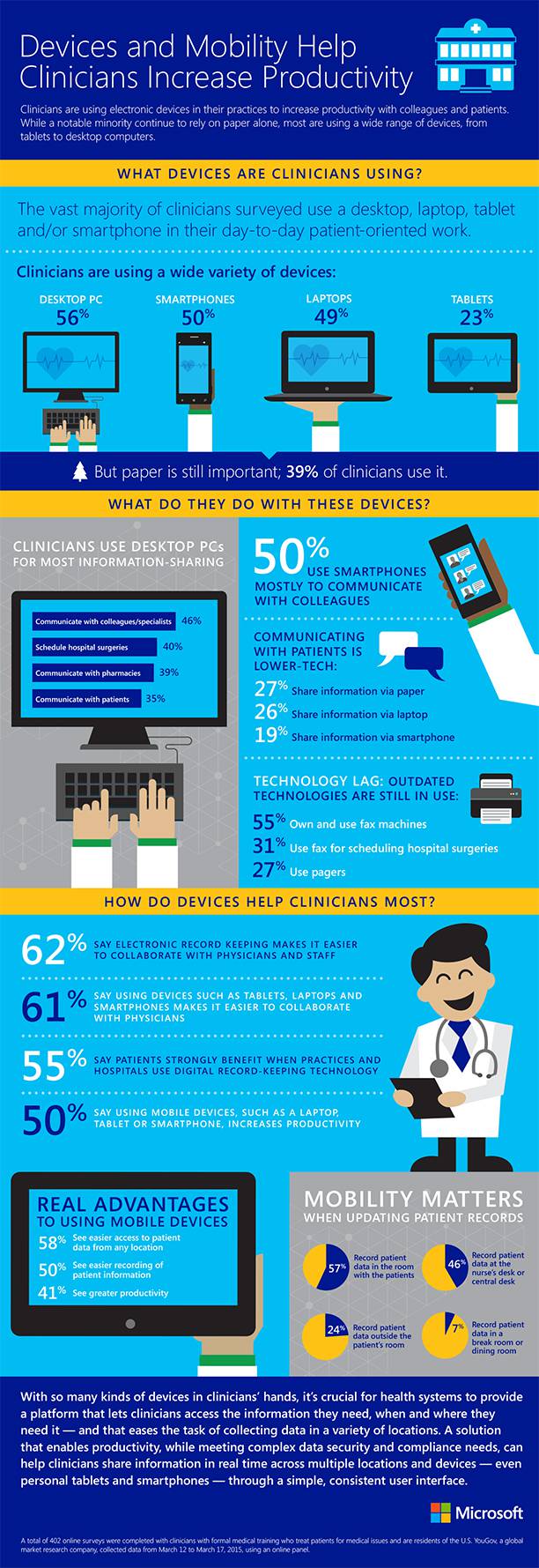Mobility means productivity for clinicians
This week Microsoft is showcasing solutions for health organizations at the HIMSS Annual Conference & Exhibition in Chicago, where we’re talking with industry leaders and IT professionals about the difference that data, devices and cloud services can make in the industry. Our discussions at HIMSS center on a number of challenges, like extending access to care and rising operational costs, among others. One underlying theme that sticks out in conversations is productivity. Specifically – how can clinicians, nurses and staff do their jobs in a more efficient, cost-effective way?
To get a clearer understanding of how technology impacts productivity in healthcare practice, we commissioned a survey of clinicians about the devices they use and how they use them. The results paint an interesting picture about methods and tools clinicians use to communicate with each other and their patients, and show opportunities for health organizations to adopt productivity tools to become more efficient.
What devices are clinicians using?
- The vast majority of clinicians use a desktop, laptop, tablet and/or smartphone in their day-to-day patient-oriented work.
- Clinicians are using a wide variety of devices – including smartphones (50%), laptops (49%), and tablets (23%) – in addition to the traditional desktop (56%).
What do they do with these devices?
- Clinicians use desktops for most information-sharing: to communicate with colleagues or specialists (46%), hospital surgery scheduling (40%), pharmacy (39%), and patients (35%).
- Clinicians also use smartphones (50%), mostly to communicate with colleagues.
How do devices help clinicians most?
- Clinicians say using devices such as tablets, laptops, and smartphones makes it easier to collaborate with physicians (61%)
- Clinicians see real advantages to using mobile devices, including easier access to patient data from any location (58%), easier recording of patient information (50%), and greater productivity (41%).
- Mobility matters when updating patient records: 57% record patient data in the room with patients, 24% record it outside the patient’s room, 7% record it in a breakroom or dining room, and 7% record it in the car.
With a variety of devices in clinicians’ hands, it’s crucial for health systems to provide a platform that lets clinicians access the information they need, when and where they need it – and that eases the task of collecting data in a variety of locations. A solution that enables productivity, while meeting complex data security and compliance needs, can help clinicians communicate in real time, share and analyze data, and streamline processes across multiple locations and devices – even personal tablets and smartphones – through a simple, consistent user interface.
See how Advocate HealthCare implemented a cloud-based platform that improves staff communications and collaboration while enabling better patient care.
For more information about Microsoft’s role in providing technology solutions for health organizations, follow us on Twitter (@Health_IT) and stay tuned to the Microsoft in Health blog for the latest updates.
You can also join the HIMSS conversation by posting on your social media channels with the hashtag #HIMSS15. If you’re on-site at the show, stop by and visit Microsoft in the exhibition hall booth #1202.





